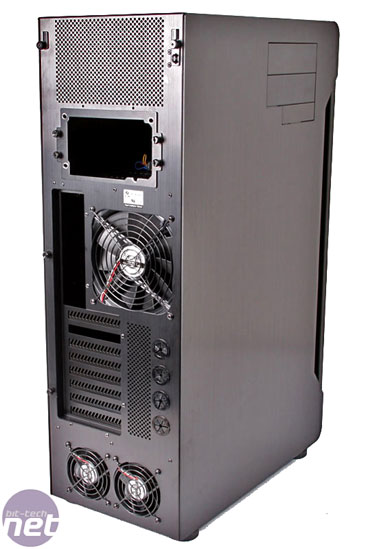
Lian Li Tyr PC-X2000
Manufacturer: Lian LiUK Price (as reviewed): TBC
US Price (as reviewed): TBC
Lian Li is one of the most respected case manufacturers in the world, and in the past it has made some of the most iconic case designs to ever grace our desks, with the PC-60 in particular holding a spot in my heart as one of the all time best cases.
However, as always, competition is fierce and a company can never afford to rest on its laurels. Lian Li has already diversified its case line up with the Lancool range, but there are also options for everything from specialised HTPCs, through to ultra high end gaming cases.
Today we’ll be looking at Lian Li's new fusion of HTPC and ultimate gaming case in the forbidding looking PC-X2000, which employs a unique and revolutionary high and thin case design. Will this skyscraper of a case come tumbling down, or will it prove to a new yardstick for high performance cases? Let's find out...
Exterior
Lian Li has certainly been thinking outside of the box while designing the PC-X2000, and it has a completely unique high rise case design. The case has been extended vertically and made shallower; resulting in a tall and thin look that reminds us of the monolith in 2001: A Space Odyssey. However, rather than accelerating evolution or causing trippy light shows like the monolith, the idea behind the PC-X2000 is that it’ll fit in with your floor standing home theatre speakers and won’t look out of place in your living room.While we’re not sure about it fitting in with your home décor, it’s a simply stunning case, with simple and elegant lines, acres of delicious black anodized aluminium and a simple silver line to break up the front panel. The entire case is constructed of the same high quality brushed black aluminium, and Lian Li has used as few sheets as possible meaning minimal joins and lines to break up the look of the case. This has resulted in the colossal single sheet side panels, each over 60cm tall, which have been beautifully machined and finished and fit perfectly over one of the PCX-2000’s unique features – side mounted 5.25-inch drive bays.
There are mounts for just two 5.25 inch drives, and one 3.5 inch drive, which can be fitted on either side of the case depending on which you’ll be accessing your PC from. The panels fit perfectly over the drive bays on both sides, and there’s only the smallest of gaps between the blanking plates. It’s a great way of including the mandatory drive bays, without compromising the look of the case front on.
The front fascia panel is also one single piece of beautifully finished aluminium, with a sole silver line used to break up the expanse of black. It’s easily pried off with a little effort to access the three 140mm intake fans housed beneath as well as a fully removable slot style washable dust filter and the fan controller for all the 140mm intake and exhaust fans.
However, there was concern in the office that the fascia was perhaps a little too easy to remove, with Joe and his clumsy muffin hands yanking it free by accident when we first unboxed the case. Other than the push in clips, there are no thumb screws or other means to secure the fascia panel to the case, so those with children might want to keep it away from inquisitive hands (or just Joe).
The front fascia panel continued to disappoint when we realised that when it had been machined, the panel had bowed inwards in the middle, making the side panels which should fit flush noticeably jut out from the front of the case. This is a disappointment considering Lian Li's build quality is legendary in the case market. Hopefully Lian Li will be able to resolve the manufacturing fault in future, but for the moment it’s a sad flaw with an otherwise gorgeous and immaculately built case.
We also had to wonder why the fan controller has been hidden behind both the fascia panel and the dust filter. While it’s arguable that the PC-X2000 is a “set and forget” type of case rather than one where you’ll be constantly tweaking fan speed, surely it would make more sense to place a fan control in an easily accessible area like the front panel, or at least one which doesn’t require you to disassemble the front of your case to access it.
The front panel itself is top mounted inside a recessed compartment with a nicely sprung flip up panel, and ticks all the boxes with what you’d expect from a high end case with four USB ports, FireWire port, 3.5mm headphone and microphone jacks and eSATA too. The nearby power and reset buttons are both metal and well finished, but the reset button will require a pen or similar object to press (even the most slender fingers won’t be able to press it in) and the power button is perhaps a little too easy to press, with very little depression required.

MSI MPG Velox 100R Chassis Review
October 14 2021 | 15:04













Want to comment? Please log in.